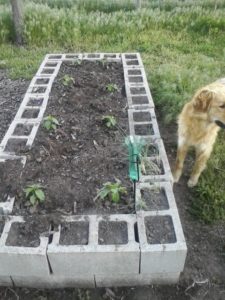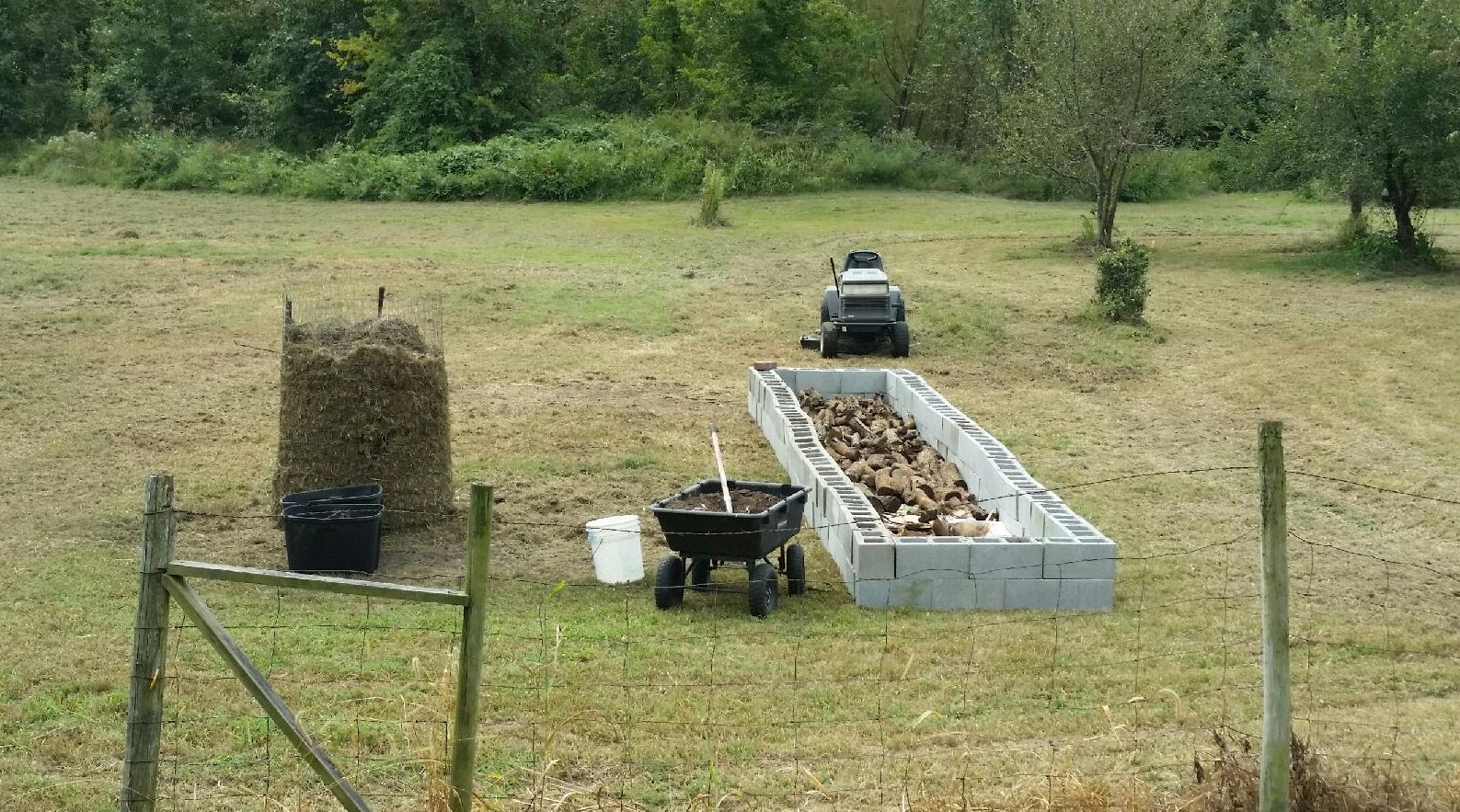Autumn is upon us, so it’s time to start thinking about garden improvements for next year. Glance over that backyard garden that began the spring with so much hope. You know, the one in the flat spot that flooded, or whose back side was overcome with grass and weeds. There’s a way that garden plot can be improved before the planting bug hits in April again: by adding Lazy Man’s Raised Beds.

One of the best ways to reduce the work and increase the rewards of gardening is by planting in raised beds. The physical separation of veggies from your lawn or a surrounding field makes weeding much easier. Having your veggies raised above the ground a foot or two is much easier on your back and knees. The soil in a bed warms up quicker in the spring, which can give you a jump on planting. If you grow fussy plants, like blueberries, a raised bed can help you manage your ph levels, organic content, drainage, etc., much better than a ground-planted garden.
But beds come with their own issues as well. Wood is expensive, attracts slugs, and eventually rots away. Beds are notoriously hard to move, re-shape, or adjust if things don’t work out as you planned. Beds can be a lot of work to build and to fill, and they can incur a lot of expense up front.
Fortunately, there is an easy way to get the advantages of raised beds while reducing some of the work and the slugs that come with traditional beds: build your beds out of cinder blocks.
Using concrete instead of wood or plastic has some tangible benefits:
Your beds aren’t permanent. With lots of other raised beds, once you mark out your territory, you’ll have raised beds in those spots forever. Their installation is just too painful to repeat. But with cinder blocks, not only can you move them, but you could make a wall or a boat anchor from them. When you’re done with that, you can re-build your beds with little fuss.
Your design can be flexible. You don’t have to make rectangles, although it’s a challenge to make circles and triangles. You can join rectangles, you can separate and divide them and you just have to move a little dirt. You can make them one block tall or two or even more and change from crop to crop. You are never stuck with an original design that may not work out the way you intended.
You can plant lots of little gardens all around the main one. On this bed, for example, I have 30 holes in which I can plant chives, marigolds, parsley, whatever I’d like. I can choose companion plants for support of the center crop, or for looks, or simply to keep a spreading herb like mint contained. My new 25’x4’ bed contains more than a hundred potential planters, giving plenty of room to experiment.

All you really need to create a workable raised bed is to stack some blocks in a rectangle, fill with dirt, and plant. They are truly the lazy man’s raised beds. However, I recommend a few extra steps that will increase the vitality of your bed while further reducing your work over the short and long term:
- Underlay the bed with hardware cloth or a double layer of chicken wire. If you manage your soil right, your bed is quickly going to fill with eathworms. That’s a good thing. But then it’s going to quickly fill with moles attempting to eat those worms. A nice bit of wire mesh underneath will keep those bad boys out.
- Pile as much cardboard as you can find on top of the wire. This is called “sheet mulching” and will ensure that nothing grows up from underneath. If you stack your bed 2 blocks high, this is probably unnecessary, but it’s still a good way to get rid of a lot of cardboard. It will be worm food before you know it.
- Fill the lowest layer of the bed with logs, sticks, and other rottables. Professional gardeners call this process hugelkultur. I call it a way to reduce the amount of dirt you need while providing your veggies with a whole lot of organic material they can use over time. Most plants only use the top 6-10” of soil anyway, so filling a bed with 18” of compost is a waste. Adding a fat layer of logs, sticks, leaves, and the like lets the bed do the composting for you. Just don’t add uncomposted grass clippings or weeds, or you’ll likely undo the benefits of your sheet mulching.
If you’re more interested in function than style, the lazy man’s raised beds can get you up and planting in a hurry while leaving you with enough freedom to fix your mistakes. But the time to get started is now, so you’ll have a place to pile all those shredded leaves for a good winter rot.










5
Great! What a clever idea. Cinder blocks are pretty easy to move around, and they’re easily attainable and affordable. If you wanted to really go crazy, you could even let your kids paint them different colors as a homeschool project.
Yes! A two for one project. Gardening and Art. Great idea.
I’ve been using cinder blocks for raised beds for a while now, but you’ve taught me a few things about how to do it better. Thanks.
Love it.
I’m about to start a sizeable rebuilding project. This will now be placed in the queue of ttd. The garden we grew this season didn’t fare to badly (even with some hail that I thought would have taken it out). However, I’ve never used beds, and this is just another good reason to give it a shot.
http://gardeningrevolution.com/ Len Pense does cinder block beds on steroids. I have been following his method for a few years. We have 4 beds 4×12 each, and grow enought tomatoes, beans, greens, and potatoes for a family of 6 year-round, not to mention squash, zuchinni, cucumbers, beets, and carrots.
4.5
I am slightly concerned about heavy metal residues leeching out of the cinder blocks. How do we ensure that the aggregate material in the cinder blocks is not fly ash from coal combustion or some other harmful substance?
3.5
I dry-stack concrete blocks 3 high, which puts the soil at around knee level–tending the garden is super easy.
A couple tips unrelated to concrete blocks: Make tomato cages out of 1/8″ rolls of rebar–the kind that looks like a role of fence, with 6″ squares, meant to lie flat in a concrete walk or slab. They rust but last forever. 4′ by 16′ cattle panels work great as trellises for beans, cucumbers, etc. My beds are 18′ to 20′ long so they fit fine, or you can use a grinding wheel or bolt cutters to cut them shorter.
I use plastic decking boards. They need maybe a few wires across the bed to help resist the pressure of the dirt pushing them apart. They are expensive but last forever, and I think help keep the soil moist in the summer. I used paver blocks under the bed, spaced out just a bit, to keep the gophers out. Never thought of chicken wire, I wonder about the cadmium or other plating on the wire.
Two more things to bury in the bed to add nutrients over time: all those cattle bones the dog drags home, and John Scalzi paperbacks. The first because calcium is awesome. But go light on the second, as too much salt is bad for the soil.
Wow! This could be one particular of the most helpful
blogs We’ve ever arrive across on this subject. Basically Magnificent.
I’m also an expert in this topic therefore
I can understand your hard work.
[…] foes, the tomato hornworm. The herbs can be grown in between tomato plants or, if you use the Lazy Man’s Raised Beds, all around the outside of the tomatoes. Just know that dill can grow four feet tall: if you grow […]